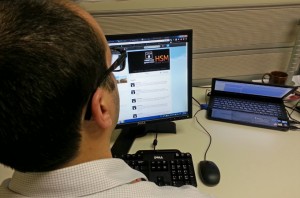
A Malian mother and child at M’béra camp in eastern Mauritania
NOUAKCHOTT/DAKAR, 9 January 2013 (IRIN) – Sequestering refugees in rural camps is no longer the norm: The most recent estimates indicate that almost half of refugees flock to urban areas and just one third to rural camps, according to the UN Refugee Agency (UNHCR). But while agencies are adjusting their approaches, they are still struggling to match their response with their policies.
UNHCR has come a long way since 1997 when its refugee response approach implied that responding to refugees in towns and cities was to be avoided. In 2009 it committed to a policy that recognized the right of displaced people to move freely, stressing that its mandate to protect refugees is not affected by their location.
There are upsides to urban support. Refugees are more likely to find work (when permitted to do so by the local authorities) and become self-sufficient in urban settings, say agencies. Because of this, though start-up costs may be higher, these should diminish over the long term. It also makes more sense for a lot of refugees who were in any case displaced from urban settings, said Jeff Crisp, head of policy development and evaluation at UNHCR.
Kellie Leeson, urban refugee strategy focal point at the International Rescue Committee (IRC), told IRIN: “Typically refugees who come to urban centres do so to find jobs – that motivation and ambition should be applauded and should spark the question: how can we take advantage of that to help them survive on their own?”
Dominique Hyde, head of the UN Children’s Fund (UNICEF) in Jordan, said Syrian refugees benefited from being in urban settings: “It’s a positive. If you look at lessons learned from Iraqis in Jordan. Living conditions are more normal, you’re not in a camp setting, your movements are not restricted. Although it is more difficult to access them, they are aware through informal networks of how to access services. Urban settings are better settings for refugees.”
“If you have a camp setting, it’s easier to count people, to provide a school, to provide a health centre. But for refugees, being in their own apartment, and being able to take their own decisions with cash assistance is preferred,” she said.
Kenya
In Kenya, many of the 45,000-100,000 refugees in the capital Nairobi fled Kakuma and Dadaab camps because of insecurity and lack of employment opportunities.
Experience shows in long-term situations camp conditions progressively decline as donor interest wanes. “Even in a competitive environment like Nairobi, you can eke out a living somehow,” said Crisp.
But in December 2012 the Kenyan government ordered Nairobi-based refugees to return to Kakuma and Dadaab, following a spate of attacks in Kenya’s northeastern Somali region and in the capital, Nairobi.
IRC has found that when it comes to creating opportunities for refugees in urban settings, programmes work best when they target both host populations and refugees. This was clearly the case in Nairobi where they teamed up with NIKE which runs a micro-franchise programme to train women aged 17-19 to set up small businesses.
“We’re trying to build networks so that it isn’t about isolated groups but refugees can engage with the host communities,” said Leeson.
“Obviously refugees will have specific protection issues but in general what they want is employment, health and education – that’s what everyone wants, right?”
The difficulty is where to draw the line between responding to refugee needs and solving the problems of the urban poor, says UNHCR’s Crisp. Refugees tend to settle among other poor and vulnerable communities, including migrants, irregular migrants and rejected asylum seekers, each of which has critical needs.
Tensions are also easily raised if aid is directed at just one group.
Studies of Nairobi-based refugees have shown urban refugees often pay higher rents than Kenyans, and are charged more for public health services and education fees, according to the Overseas Development Institute’s Humanitarian Policy Group.
Inclusive programmes
In San Diego and New York City in the USA, IRC works with local authorities to access land for ex-refugees from Burkina Faso, Myanmar, Cameroon and all over, who have resettled, to grow urban gardens. So as not to aggravate tensions, and to promote inclusion, the programme invites locals to get involved too.
Responding in urban settings involves having to work with new partners, such as the municipal authorities, so that refugees are integrated into existing education and health systems, rather than creating parallel ones. “These [urban authorities] are new partners and we are in the early stages of engaging with them… it involves a big shift,” said Crisp.
Local authorities are not always open to addressing refugee needs, and may prioritize rural camps over urban-based aid, according to UNHCR.
Mauritania
In Mauritania, both the local authorities and UNHCR have pushed refugees to stay in Mbéra camp in the east, if they want to receive aid, refugee groups in the capital, Nouakchott, told IRIN.
Refugees elsewhere – including for instance, Syrian refugees in Turkey – face a similar situation.
In Mauritania some 57,000 refugees are registered at Mbéra, while refugee group the Association of Refugees and Victims of Azawad and the Urban Community of Nouakchott (CUN), which represents the nine municipal authorities of Nouakchott, estimate a further 15,000 Malians fled to the capital, but no urban registration process took place, so the number is not known.
UNHCR has no immediate plans to address Nouakchott-based refugee needs. “The authorities have been very clear – that humanitarian aid is for those who are in the camp. Our strategy here is not for urban refugees in the capital,” said Elise Villechalane, reports officer for UNHCR in Nouakchott at the end of 2012.
“Our priority is to save lives immediately. It may evolve over time, but that is the current priority.”
Malians in Nouakchott come from both the Islamist-held north and from Kati and Bamako in the south following the March 2012 military coup. Many of the refugees are ex-government officials or other individuals with some means and thus may not be eligible in any case, for vulnerability-led aid, noted refugee groups.
Refugees who reach capital cities often create a “self-selection process” as they tend to be more educated and have more means to get to the capital in the first place.
However, agencies have moved away from making the assumption that only “young able-bodied men reach capital cities”, said Crisp. “We know they are a diverse group made up of women, children, men, people with disabilities, and other vulnerabilities.”
Many Malians arrived in Nouakchott with nothing, having used their resources to get there, said Zakiatou Oualette Alatine, an ex-Malian minister in Kati, and now spokesperson for the Association of Refugees and Victims of Azawad. “Many of us arrived empty-handed. Some of the young have found jobs but many of them are exploited as they don’t have refugee status. Most rely on extended family. A minority begs for money,” Kati told IRIN.
Both she and Safia Mint Moulay, representative of Karama, an association that represents Malian refugees in Nouakchott, said what urban refugees need most is identification papers. Without refugee cards they are unable to get a job or attend school, said Moulay. “These people have real needs… Getting their papers – that is the key to everything. If they have papers then they have a right to receive food aid, blankets, shelter and protection,” she said.
These refugees do not want to go to Mbéra as they will not be able to work at all, said Alatine. Refugees have criticized life in the camps and the lack of schools.
CUN, alongside the international association of francophone mayors, gave 60,000 euros (US$78,500) for food for urban refugees, said Mohamed Fouad Berrad, CUN’s presidential adviser, but resources would need to come from elsewhere in future.
Shift in mind-set required
Getting urban refugee responses right requires a shift in mind-set, says IRC’s Leeson. “We can’t say let’s just do what we did before and translate it to an urban setting. We need to be more thoughtful about what we are doing.”
Too often refugees flee insecurity in camps only to face new forms of insecurity in cities, say refugee agencies. Urban refugees are often highly mobile and invisible, making them hard to protect. A study of Nairobi-based refugees by the Humanitarian Policy Group, IRC and the Refugee Consortium of Kenya, noted urban refugees were too fearful of deportation to make themselves visible and demand their rights. Host states must be pressured into recognizing refugee rights to protection and giving them a clearer legal status, the report recommends.
Refugee associations in Nouakchott have been campaigning with the government, but little has shifted, they said.
UNHCR is still learning but the organization has put more time and resources into turning its urban refugee policy into practice than almost any other strategy, said Crisp.
“We are still in a transitional phrase. It isn’t quite prominent yet for everyone. But we need to get everyone orientated to the urban context,” he said.
The agency is collating best practice from urban responses globally, including in Malaysia, Ethiopia, Uganda, Ecuador, India, Tajikistan and Bulgaria, which will be available on a database this year.
To turn such best practice into a systematic reality will inevitably require more resources, Crisp noted. UNHCR launched record-level appeals amounting to US$3.6 billion in 2012, due to several high-profile refugee crises, and the funding is not in place to allocate or train staff dedicated specifically to addressing the challenges of urban response.
From IRIN: Humanitaian News and Analysis, a service of the UN office for the Coordination of Humanitarian Affairs.
aj/eo/mk/cb








